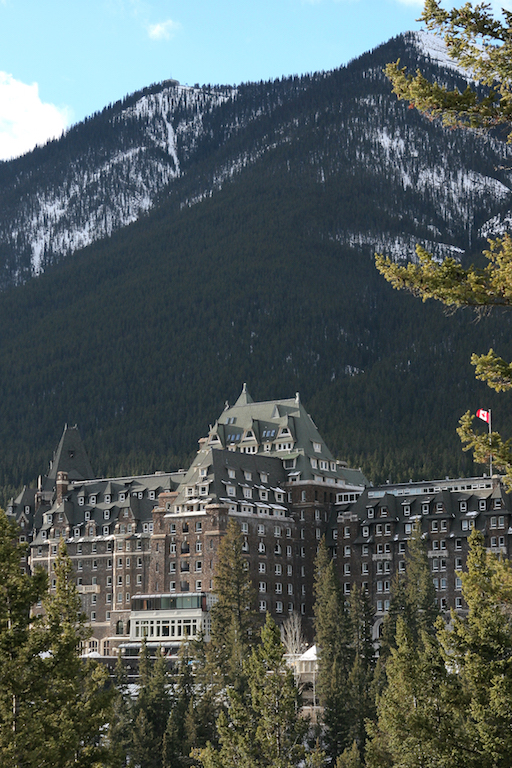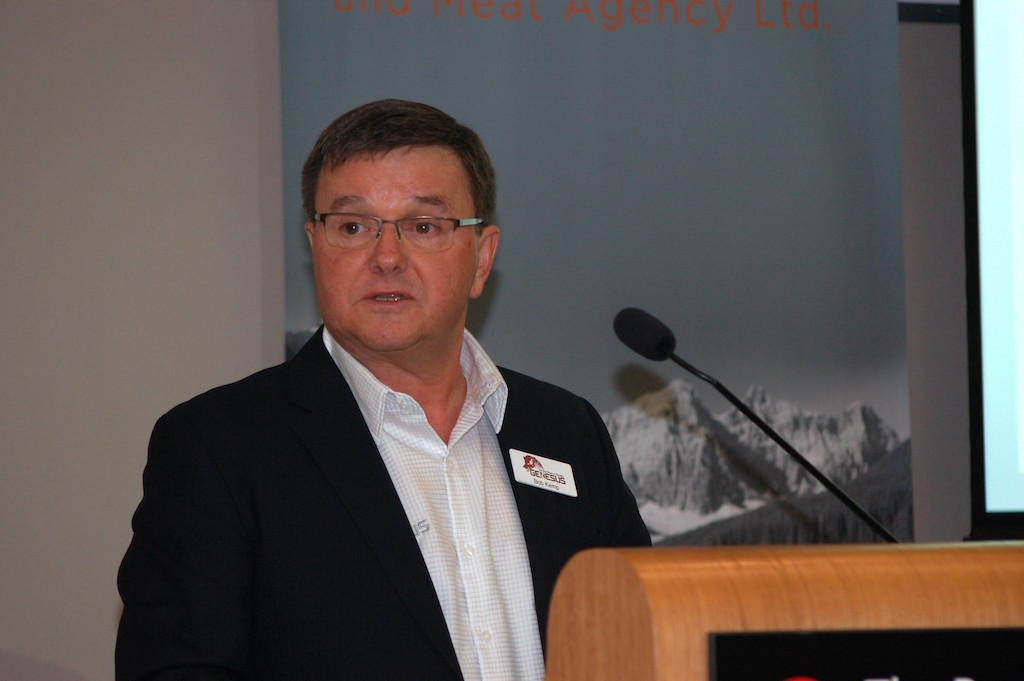Banff Pork Seminar will celebrate its 45th anniversary with a move back to its former home – the internationally renowned Fairmont Banff Springs hotel and convention centre.
The oldest and likely the most photographed tourist facility in Canada’s park system, the original wing of the Banff Springs was built in the mid-1880s and opened for business in 1888 at the urging of William Cornelius Van Horne, president of the Canadian Pacific Railway and charged with building Canada’s first transcontinental line.
Van Horne felt that the site near the hot springs at the foot of Sulphur Mountain might attract a strong following of well-heeled tourists, thus becoming a solid money maker for the parallel ribbons of steel that tied Canada together in the late 19th Century.
One hundred and twenty-seven years later, Van Horne’s inkling continues to inspire the millions of people who have visited the town and ogled the Tudor-style castle overlooking Spray River – including a healthy representation of Canada’s pork industry.


Banff Pork program director Ruurd Zijlstra and conference chair Bob Kemp announced the move during the final session of the 2015 seminar, confirming rumours that had been building and circulating among the 616 delegates gathered for the annual seminar.
From a purely practical note, the BPS contract with Banff Centre was up for renewal and the board was shopping for offers, Kemp said in an interview with Prairie Hog Country after the announcement.
“I think it will be a good move. I think people will like it. Will there be some growing pains? Probably,” said Kemp.
As was done at the expiration of previous contracts, the board wanted to perform its due diligence in setting up its successor.
This time around, the Fairmont Banff Springs was clearly the most attractive option.
Moving out of Banff was not an option for the advisory board in considering where it would hold is seminars in 2016 through 2018, said Kemp.
That left three choices: Stay at the Banff Centre, move to the Banff Springs or spread the conference among two or three adjacent hotels in the centre of town.
“We could have gone to two or three hotels that are close together and utilized their facilities. We looked at that and decided, well, we really didn’t think spreading it over two or three hotels was a good thing to do,” said Kemp.
Fairmont Banff Springs presented the board with an irresistible deal, massaging its offer during negotiations with the BPS advisory board, said Kemp.
Among the main aspects of the Banff Springs bid was that the BPS advisory board would have cost control over the three years of the contract, meaning the hotel could not fiddle with its prices from year to year.
Facility-wise, members of the board had made a series of tours to inspect the Banff Springs hotel and convention facilities. Based on those visits, they believe that its setting as a hotel and convention centre is more conducive to the needs of Banff Pork Seminar, said Kemp.
”The Banff Springs bid was extremely competitive right from the start and they were very interested in having our business and they adjusted their bid and did some things to make the bid work very well for us,” he said.
“(Kinnear Centre) is a difficult room to work with, there’s no question. (Banff Springs) is a conference facility, so there is a lot more flexibility in what can be done. I think it really will be conducive to people being able to interact, and that’s important.”
First held in Olds and then moved to Banff, the conference had been located at the Banff Springs for a number of years, but moved to the Banff Centre after outgrowing the facilities there.
It was sometime after the BPS had moved across the river to the Banff Centre that construction was started on a new convention centre attached to the Banff Springs.
Kemp said he believes the arrangements now being made for next years’ seminar will answer most concerns expressed by delegates, including maintaining the shuttle service between the hotel and the town centre.
Evening networking at the Irish pub – a tradition flowing back to the days when the late Frank Aherne was a central figure in the seminar – should continue as in the past, said Kemp.
There should also be no issues for those who choose to walk back and forth between the conference and the town centre, he said.
One of the BPS advisory board members did some test walks to see whether the Banff Springs was significantly farther than the Banff Centre.
“They’re within a couple of minutes of each other,” said Kemp.
“There’s no large hill to ascend and descend. It’s all street lights and sidewalks and a very safe environment for walking.”
Kemp addressed the broader goals and theme of the Banff Pork Seminar in his opening remarks to the delegates attending the 2015 conference.
“Logically, if the industry is faced with rapid evolution, institutions such as the Banff Pork Seminar have to keep pace.
We have to find ways to continue to tap the best minds of the industry, to provide leadership,” he said.
“The world this industry finds itself in is moving so quickly (with) issues such as feed costs, pork prices, disease challenges, labor challenges, currency fluctuations, market access, animal welfare, rising protein demand to name a few.

“Given that backdrop of a need for the industry to respond to multiple issues, we chose Adapting and Evolving as the theme for this year’s seminar. Clearly there are tremendous opportunities for those who are willing to adapt and evolve.”
Striding toward that goal is attained in part by the seminar’s ongoing series of awards offered to scientists, students and industry innovators.
Those awards have continued to expand through the years, including the F.X. Aherne award for innovation, the R.O. Ball Young Scientist Award and the George Foxcroft Lectureship in Swine Production.
The awards were presented throughout the seminar and announced at the final session on Jan. 22. See page 44 for pictures.
The Aherne award, named for a University of Alberta swine research scientist who was a pillar of the Banff Pork Seminar, offers prizes for people in various sectors of the industry who have found innovative solutions for common problems.
Two winners were selected for the 2015 award:
Lyle and Maaike Campbell of Birnam Pork, Arkona, ON were awarded for a scale especially adapted to tracking litters and weighing piglets, while Greg Feenstra and Dave Uttecht of Heartland Pork in Alpena, South Dakota, were awarded for their EZ Tub hog handling innovation, developed to reduce stress on animals and people.
The Campbell’s developed their low-cost scale to ensure that they are shipping weaners that most closely meet their marketing objectives and therefore perform well as growers and finishers.
Feenstra and Uttecht’s EZ Tub hog handler accomplishes similar goals by being a relatively low-cost system that helps improve safety and efficiency in the barn with a resulting benefit at the packing plant.
The EZ Tub is designed to work with the tendency of pigs to circle, creating a natural flow when moving hogs onto a trailer, thereby reducing the stress and injuries on pigs that are heading to market. The animals load more easily and therefore travel better, resulting in fewer discounts at the plant for stress and injuries.
The R.O. Ball award, named after another U of A researcher who played a key role in the success of the Banff Pork Seminar, recognizes two graduate students who demonstrate excellence in performing excellent and relevant science and are also able to share their findings through well-written abstracts and oral presentations.
Natalie May from the U of A swine program won the first prize of $500 for her work on identification of seminal plasma proteins associated with boar fertility.
Janelle Fouhse, also a graduate student at the U of A, was awarded the second-place prize of $250 for her paper on starch and fibre characteristics of barley which influence energy digestion in grower pigs.
The most recent addition to the Banff Pork Seminar awards is the George Foxcroft Lectureship, created in honour of yet another former U of A professor who has a long history of contributions to the conference.
The Foxcroft Lectureship was established by Banff Pork Seminar and the U of A to award speakers who conduct high-profile research geared toward improving production efficiency.
Genetics specialist Egbert Knol of Topigs Norsvin Canada was presented the 2015 award after conducting a session addressing whether genetics are meeting challenges in the North America’s swine industry.
In his remarks to delegates, Zijlstra reminded delegates of the primary goals of the Banff Pork Seminar: To bring together a strong mix of expertise for formal discussion of various topics and also to create an opportunity for informal networking among people who have a vested interest in promoting a strong and healthy industry.
Banff Pork Seminar is a joint project of Alberta Pork, the University of Alberta and Alberta Agriculture and Rural Development, operated by an organizing committee of industry people from across the country.
The various industry partners who sponsor the seminar play a key role in its ability to continue bringing top speakers from across the continent and around the world.
Without their support, the cost per delegates would rise by $300 apiece, said Zijlstra.
He and Kemp also announced that, along with the move, dates have been changed for the next three editions of Banff Pork Seminar.
Next year’s program is scheduled for Jan 12-14. The 2017 programs runs on Jan 12-14 and 2018 goes Jan. 9-11. •
— By Brenda Kossowan





